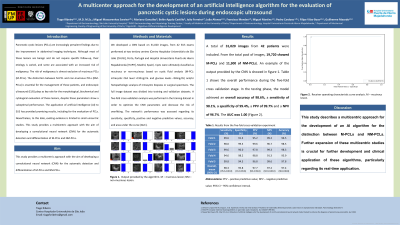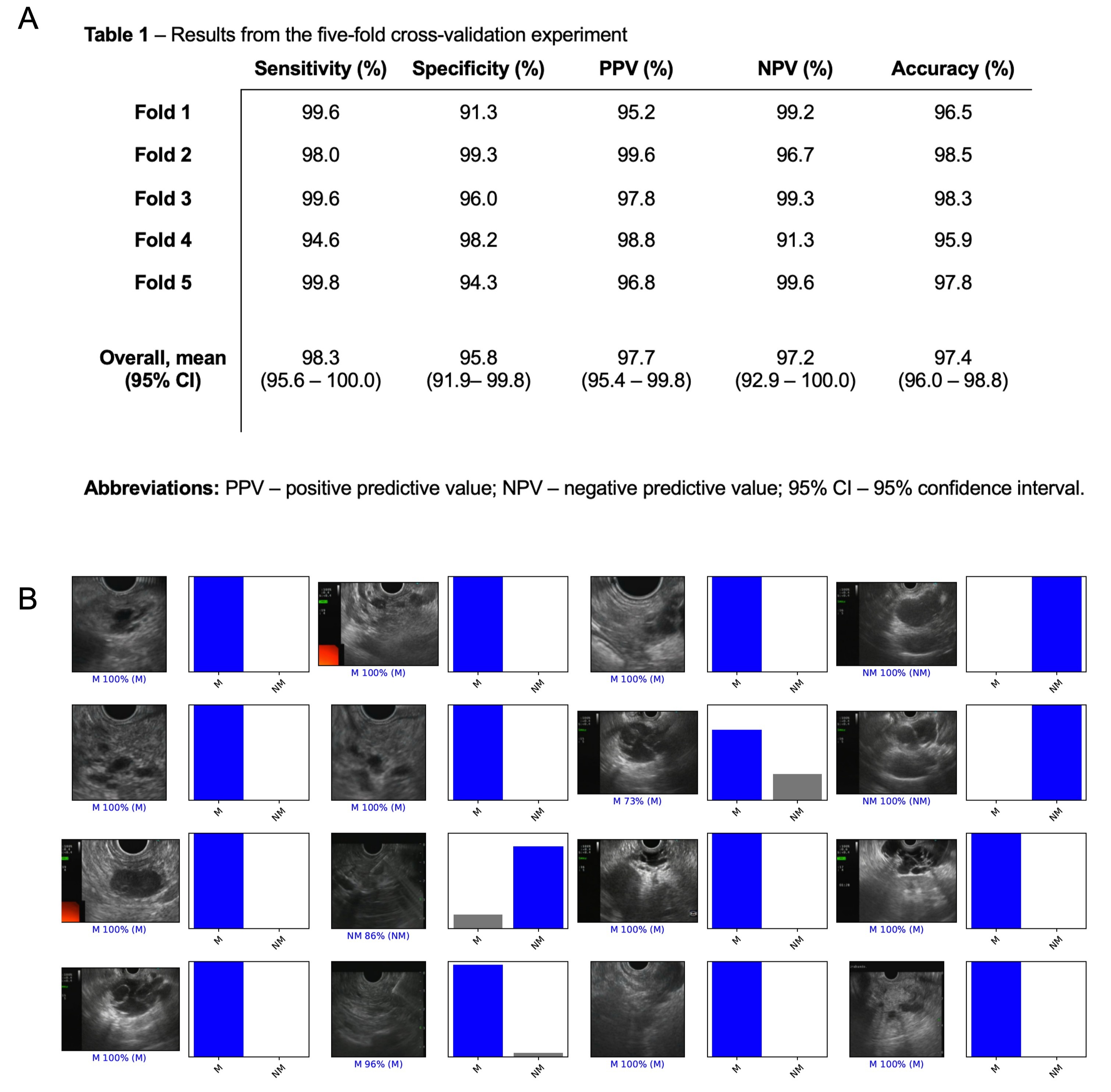Monday Poster Session
Category: Biliary/Pancreas
P1421 - Deep Learning and Endoscopic Ultrasound: Automatic Characterization of Pancreatic Cystic Lesions - A Bicentric Study
Monday, October 23, 2023
10:30 AM - 4:15 PM PT
Location: Exhibit Hall

Has Audio
- TR
Tiago Ribeiro, MD
Centro Hospitalar São João
Porto, Porto, Portugal
Presenting Author(s)
Award: Presidential Poster Award
Tiago Ribeiro, MD1, Miguel Mascarenhas, MD2, Mariano Gonzalez, MD3, Belen Agudo, MD3, João Ferreira, PhD4, João PL. Afonso, MD5, Francisco Mendes, MD1, Miguel Martins, MD1, Pedro Cardoso, MD2, Filipe Vilas-Boas, MD, PhD2, Guilherme Macedo, MD, PhD5
1Centro Hospitalar São João, Porto, Porto, Portugal; 2Centro Hospitalar Universitário de São João, Porto, Porto, Portugal; 3Hospital Universitario Puerta de Hierro Majadahonda, Madrid, Madrid, Spain; 4University of Porto-FEUP, Porto, Porto, Portugal; 5Centro Hospitalar de São João, Porto, Porto, Portugal
Introduction: Pancreatic cystic lesions (PCLs) are increasingly prevalent findings due to the improvement in abdominal imaging techniques. The risk of malignancy is almost exclusive of mucinous PCLs (M-PCLs). Thus, the distinction between M-PCL and non-mucinous PCLs (NM-PCLs) is essential for the management of these patients, and endoscopic ultrasound (EUS) plays as key role for the morphological, biochemical and cytological evaluation of these lesions, despite its suboptimal performance. The application of artificial intelligence (AI) to EUS has provided promising results, including for the evaluation of PCLs. Nevertheless, to this date, existing evidence is scarce. This study provides a multicentric approach with the aim of developing a convolutional neural network (CNN) for the automatic differentiation between M-PCLs and NM-PCLs.
Methods: We developed a CNN based on 31,020 images, from 42 EUS exams performed at two tertiary centres (Centro Hospitalar Universitário de São João [CHUSJ], Porto, Portugal and Hospital Universitario Puerta de Hierro Majadahonda [HUPH], Madrid, Spain). Cysts were ultimately classified as mucinous or non-mucinous based on cystic fluid analysis (M-PCL: intracystic CEA level >192ng/mL and glucose levels < 50mg/dL) and/or histopathologic analysis of intracystic biopsies or surgical specimens. The full image dataset was divided into training and validation datasets. A five-fold cross-validation analysis was performed in the training dataset in order to optimize the CNN parameters and decrease the risk of overfitting. The network's performance was assessed regarding its sensitivity, specificity, positive and negative predictive values, accuracy, and area under the curve (AUC).
Results: A total of 31,020 images from 42 patients were included. From the total pool of images, 19,720 showed M-PCLs and 11,300 of NM-PCLs). The table depicted in Figure 1a shows the overall performance during the five-fold cross validation stage. An example of the output provided by the CNN is showed in figure 1b. In the testing phase, the model achieved an overall accuracy of 98.6%, a sensitivity of 98.1%, a specificity of 99.4%, a PPV of 99.7% and a NPV of 96.7%. The AUC was 1.00.
Discussion: This study describes a multicentric approach for the development of an AI algorithm for the distinction between M-PCLs and NM-PCLs. Further expansion of these multicentric studies is crucial for further development and clinical application of these algorithms, particularly regarding its real-time application.

Disclosures:
Tiago Ribeiro, MD1, Miguel Mascarenhas, MD2, Mariano Gonzalez, MD3, Belen Agudo, MD3, João Ferreira, PhD4, João PL. Afonso, MD5, Francisco Mendes, MD1, Miguel Martins, MD1, Pedro Cardoso, MD2, Filipe Vilas-Boas, MD, PhD2, Guilherme Macedo, MD, PhD5. P1421 - Deep Learning and Endoscopic Ultrasound: Automatic Characterization of Pancreatic Cystic Lesions - A Bicentric Study, ACG 2023 Annual Scientific Meeting Abstracts. Vancouver, BC, Canada: American College of Gastroenterology.
Tiago Ribeiro, MD1, Miguel Mascarenhas, MD2, Mariano Gonzalez, MD3, Belen Agudo, MD3, João Ferreira, PhD4, João PL. Afonso, MD5, Francisco Mendes, MD1, Miguel Martins, MD1, Pedro Cardoso, MD2, Filipe Vilas-Boas, MD, PhD2, Guilherme Macedo, MD, PhD5
1Centro Hospitalar São João, Porto, Porto, Portugal; 2Centro Hospitalar Universitário de São João, Porto, Porto, Portugal; 3Hospital Universitario Puerta de Hierro Majadahonda, Madrid, Madrid, Spain; 4University of Porto-FEUP, Porto, Porto, Portugal; 5Centro Hospitalar de São João, Porto, Porto, Portugal
Introduction: Pancreatic cystic lesions (PCLs) are increasingly prevalent findings due to the improvement in abdominal imaging techniques. The risk of malignancy is almost exclusive of mucinous PCLs (M-PCLs). Thus, the distinction between M-PCL and non-mucinous PCLs (NM-PCLs) is essential for the management of these patients, and endoscopic ultrasound (EUS) plays as key role for the morphological, biochemical and cytological evaluation of these lesions, despite its suboptimal performance. The application of artificial intelligence (AI) to EUS has provided promising results, including for the evaluation of PCLs. Nevertheless, to this date, existing evidence is scarce. This study provides a multicentric approach with the aim of developing a convolutional neural network (CNN) for the automatic differentiation between M-PCLs and NM-PCLs.
Methods: We developed a CNN based on 31,020 images, from 42 EUS exams performed at two tertiary centres (Centro Hospitalar Universitário de São João [CHUSJ], Porto, Portugal and Hospital Universitario Puerta de Hierro Majadahonda [HUPH], Madrid, Spain). Cysts were ultimately classified as mucinous or non-mucinous based on cystic fluid analysis (M-PCL: intracystic CEA level >192ng/mL and glucose levels < 50mg/dL) and/or histopathologic analysis of intracystic biopsies or surgical specimens. The full image dataset was divided into training and validation datasets. A five-fold cross-validation analysis was performed in the training dataset in order to optimize the CNN parameters and decrease the risk of overfitting. The network's performance was assessed regarding its sensitivity, specificity, positive and negative predictive values, accuracy, and area under the curve (AUC).
Results: A total of 31,020 images from 42 patients were included. From the total pool of images, 19,720 showed M-PCLs and 11,300 of NM-PCLs). The table depicted in Figure 1a shows the overall performance during the five-fold cross validation stage. An example of the output provided by the CNN is showed in figure 1b. In the testing phase, the model achieved an overall accuracy of 98.6%, a sensitivity of 98.1%, a specificity of 99.4%, a PPV of 99.7% and a NPV of 96.7%. The AUC was 1.00.
Discussion: This study describes a multicentric approach for the development of an AI algorithm for the distinction between M-PCLs and NM-PCLs. Further expansion of these multicentric studies is crucial for further development and clinical application of these algorithms, particularly regarding its real-time application.

Figure: Figure 1. A - Five-fold cross-validation. B - Output provided by the network, regarding the differentiation between Mucinous pancreatic cystic lesions (M) and non-mucinous pancreatic cystic lesions (NM).
Disclosures:
Tiago Ribeiro indicated no relevant financial relationships.
Miguel Mascarenhas indicated no relevant financial relationships.
Mariano Gonzalez indicated no relevant financial relationships.
Belen Agudo indicated no relevant financial relationships.
João Ferreira indicated no relevant financial relationships.
João Afonso indicated no relevant financial relationships.
Francisco Mendes indicated no relevant financial relationships.
Miguel Martins indicated no relevant financial relationships.
Pedro Cardoso indicated no relevant financial relationships.
Filipe Vilas-Boas indicated no relevant financial relationships.
Guilherme Macedo indicated no relevant financial relationships.
Tiago Ribeiro, MD1, Miguel Mascarenhas, MD2, Mariano Gonzalez, MD3, Belen Agudo, MD3, João Ferreira, PhD4, João PL. Afonso, MD5, Francisco Mendes, MD1, Miguel Martins, MD1, Pedro Cardoso, MD2, Filipe Vilas-Boas, MD, PhD2, Guilherme Macedo, MD, PhD5. P1421 - Deep Learning and Endoscopic Ultrasound: Automatic Characterization of Pancreatic Cystic Lesions - A Bicentric Study, ACG 2023 Annual Scientific Meeting Abstracts. Vancouver, BC, Canada: American College of Gastroenterology.

